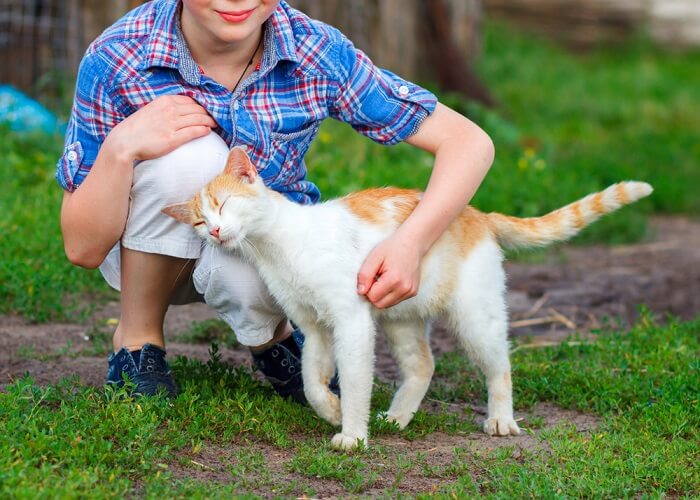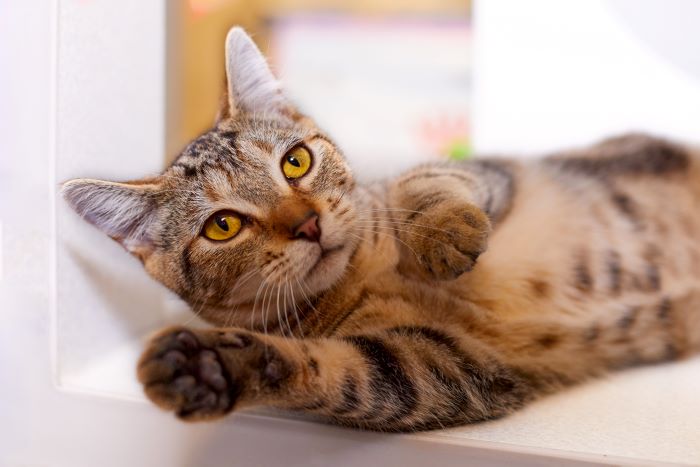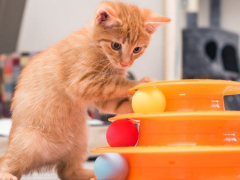
The love and trust a pet bestows upon us is unconditional. Most cats ask little in return. All we must do is provide food and shelter, take care of them, and enrich their environment to make all their natural desires come true.
Cats show love through behaviors like purring, slow blinking, and head-butting. Studies indicate cats recognize their owners' voices and can form strong emotional bonds. Unlike dogs, cats have unique ways of expressing affection that are often subtle and easily misunderstood.Key Takeaways
For many folks, our furry companion is the ‘love’ of our life, with whom we share our daily pleasures and challenges, but how can we know if it’s reciprocated, especially since cats are known to be solitary and enigmatic?
Let’s explore intimately how cats convey ‘love’ and ways to help them to become content around us.
Do Cats Love Us?
Cats are a unique, intelligent, complex species that forms distinct bonds with their owners based on genetics, temperament, early socialization, and former experiences.
Cats don’t feel or display love the exact way humans do, but they’re influenced by positive and negative emotional motivators. A recent study discovered that felines care more about humans and use them as a source of comfort to feel secure once they are distressed.
The devotion a cat feels and shares with their parent can be just as solid as with a dog. Indeed, some moggies even get over-attached to their owners and may suffer separation-related problems.
If a cat chooses to spend time with you, looks forward to seeing you come home, and displays fondness, then the animal is bonded to you!
How Cats Show Love?

Although cats may show ‘love’ by demonstrating behaviour that can seem peculiar to us, cats are a cautious species and express affection and ease around another human or pet by using multi-sensory modalities (visual combined with olfactory and tactile) to relay diverse meanings.
Generally, body postures and behaviour give an overall impression of the emotional state together with the intention of the cat, whereas facial expressions provide more current info which may be altered rapidly in response to ever-changing situations.
Hence, it’s essential to read postural and variable facial expressions collectively to gain an accurate assessment of how your companion is feeling.
Certain visual signals communicate intent to make distance (hostile signals referred to as distance-increasing signals) while others express the intention to decrease distance (harmonious indications called distance-decreasing signals).
The latter tend to only be directed to those individuals the cat is familiar with and wants to interact with.
Visual signals that a cat would like to decrease the distance from an individual include holding the tail up, social rolling, and slow blinking.
Scientists are now getting down to examine how cats and folks interconnect. Initial research showed that cats can follow people pointing gestures but lack a few of the behaviours dogs display, such as repeated staring at the person whilst purring is used by certain cats to solicit food, attention, and other desires from humans.
They also found that cats answer their owner’s name calling, however don’t respond to strangers who imitate their owner’s call (Heath, 2016).
Based on this research and our understanding of feline communication, we have identified several signs your cat feels comfortable around you.
Signs Your Cat Loves You
Our feline companions signal ‘love’ by displaying a few of the following behaviours:
1. Bunting
Bunting occurs when your cat deposits chemical messages by facial rubbing their cheeks on you, brushing objects, walls, and furniture. Many cats also head-butt their humans with their forehead or brush against their heads.
Depositing of such scent messages conveys territoriality, helps a kitty feel more familiar in their environment, and is related with comfort together with friendly social interactions with someone they love and really do care about their owners.
2. Social Rolling
This behaviour occurs in a number of circumstances, and it’s directed towards people, other cats, and in some situations, to other household pets the cat has a great relationship with.
When a cat is rolling as part of a social interaction with its owner as seen during this video, it transmits a greeting behaviour, communicating friendly intent and invitation to approach.
While it may act as an invite, it’s often misinterpreted as a proposal to touch the belly region, which it’s not, since a cat may get surprised and lash out by biting. We don’t recommend stroking a cat in this area unless your cat enjoys it.
3. Purring

While cats may occasionally also purr to comfort themselves in an unpleasant situation, purring usually indicates a feeling of comfort and wellbeing.
Purring usually communicates some variety of pleasure, presumably contentment.
Cats purr in a number of different contexts considered positive, for instance:
- Kittens purr during nursing, and mothers purr whilst nursing kittens
- When being stroked, talked to, or resting on a person’s lap
- Resting or rubbing against a favoured pet companion
- When being groomed by another cat or person
Purring in positive contexts could also be further reinforced by folks who continue to perform the behaviour that caused the purring as they find listening to purring enjoyable – thus the cat learns that purring causes the favoured behaviour to continue.
It’s worth noting that cats also purr in situations that might be considered negative; when cats are in pain, queens during labour, and while dying.
4. Kneading
Kneading could be a heartwarming behaviour where cats paddle the front paws, usually on a soft surface or the owner’s lap. This behaviour stems from kittenhood when kittens knead mum while feeding to stimulate milk flow.
Kneading persisted into adulthood mostly takes place just before settling down or when your cat is feeling content, relaxed, and adored.
5. Grooming
Cats spend lots of time self-grooming and allogrooming (two cats grooming one another). Similarly, when your cat licks your skin, nibbles your hand, or suckles on clothing, they’re presumably engaging in scent exchange to make a grouping scent, meaning you become a part of their family.
6. Slow Blinking
Eyes are important in signalling moods. A brand-new indicator which is under scientific investigation is known as the slow blink. Slow blink succession usually carries with it a series of half-blinks followed by prolonged eye narrowing or closure.
The slow blink appears to be directed towards humans rather than other cats. It signifies a positive emotional message within which a cat is comfortable with the individual presence or accepts their attention and trust, however it isn’t an invite to come closer necessarily.
To help relax your kitty, respond by blinking slowly in their direction and shift your gaze away to seem non-threatening.
Conclusion
Cats are fascinating species who communicate ‘love’ and devotion in an exceedingly different manner reliant on the context of the situation and owner attachment.
You can reciprocate the love back by observing together with educating yourself regarding felines and admire the differences between us.
Frequently Asked Questions:
Do cats get attached to owners?
Although domestic cats conventionally been viewed as unsociable. There’s large body of evidence to suggest that cats are complex individuals capable of forming deep social relationships with humans.
Do cats forget you?
Although there’s insufficient scientific evidence to verify cat’s memory traits, it’s recognised that certain cats can easily adapt to new environments based on previous memory experiences.
Individual relationships with people, intelligence differences, health conditions and age may affect a cat’s memory. Generally, a cat will remember their owner including associated experiences.
Why do cats lick you?
Cats typically lick themselves during grooming sessions whereas queens lick their kittens while nursing. Allogrooming mainly occurs among siblings or cats with a powerful closeness to boost a social bond.
When a cat expresses affiliative social behaviour by licking a person’s hand or face, this kind of scent exchange discloses sign of affection.
Furthermore, cats are emotionally sensitive, tuned in to their owner’s feelings, you’ll find your cat licking you to soothe your anxiety throughout illness or tough times.
Why do cats rub against you?
Usually, when our moggies rub against items, they leave a chemical scent to proclaim the item or area as their territory, it’s theorized that facial rubbing towards humans communicates possible ownership, close social bond and acceptance.
Do Cats Love Us?
If a cat chooses to spend time with you, looks forward to seeing you come home, and displays fondness, then your cat really does love you!
-
Beth Adelman, M. (2018, November 26). Do Cats Love Us? Science Says Yes! Retrieved February 21, 2021, from Fear Free Happy Homes: https://fearfreehappyhomes.com/do-cats-love-us-science-says-yes/
-
Care, I. C. (2020, September 01). Feline Senses and Communication. Advanced Feline Behaviour Course for Vet Professionals. United Kingdom: International Cat Care. Retrieved February 22, 2021
-
Heath, I. R. (2016). Feline Behavioral Health and Welfare. St Louis, MO: Elsevier. Retrieved February 20, 2021
-
Mills, L. S. (2021, January 11). Introducing a Controlled Outdoor Environment Impacts Positively in Cat Welfare and Owner Concerns: The Use of a New Feline Welfare Assessment Tool. (F. i. Science, Compiler) United Kingdom. Retrieved February 22, 2020, from https://www.frontiersin.org/articles/10.3389/fvets.2020.599284/full
-
Tasmin Humphrey, L. P. (2020, October 05). The role of cat eye narrowing movements in cat–human communication. (S. Reports, Compiler) Retrieved February 14, 2020, from https://www.nature.com/articles/s41598-020-73426-0
-
Care, I. C. (2018, October 05). Cat Communication. Retrieved February 17, 2021, from International Cat Care: https://icatcare.org/advice/cat-communication/
-
Halls, V. (2011). Furry babies or felines - do we really know our cats? Retrieved February 18th, 2021 from Vicky Halls: http://www.vickyhalls.net/guides/The%20Cat%20Winter%202011%20-%20Furry%20babies%20or%20felines.pdf
-
Halls, V. (2012). Cats and people – Getting the Relationship Right. UK. Retrieved February 16th, 2021
-
Bradshaw, J. (2013, September 14). More than a feline. (N. Scientist, Compiler) UK. Retrieved February 22, 2021








My cat is not very affectionate. But, I think she is playing with me. When I walk in the room she runs away, then stops and looks back to see if I am following her. She will hide behind furniture and jump out at me. She doesn’t seem agressive she seems like she is playing with me. Do cats do that?
Hi Carol
Yes, it’s common for cats to display playful behavior, especially when they are adolescents or young. It’s important to continue playing with her to keep her active and engaged. However, it’s essential not to encourage any behavior that involves attacking feet, as this can lead to inappropriate behavior as she grows older. Instead, redirect her focus to appropriate toys and activities during playtime.
All the best
Melina
I have a 14 week old kitten and I just experienced unconditional love. I forgot his feeding time by a few hours and felt AWFUL despite getting it 95% of the time. I was crying while he was eating and afterwards, came to me and I picked him up.
He starting purring, licking my face and snuggling into me. No doubt he has bonded with me. Pets just enrich our lives in unexpected ways…
My 1 year old cat leads me to the bathroom, to the kitchen, everywhere. I follow my cat to my usual places. when I am resting she sleeps in the cat tree or on my bed. When I move she wakes and stands before me like a guard dog. Why does she do this?
Hi Emma,
From what I can tell, you have a close relationship with your one-year-old cat.
Guarding is usually a protective behavior that is often a sign of affection.
I suggest reading this informative article: 10 Signs You Might Have a Clingy Cat (https://cats.com/clingy-cat-10-signs), to determine if your cat’s behavior is becoming too clingy.
Enjoy spending time together.
Melina
I have two cats One is the email she’s older by year the other one is a male I love them both and they got along really good I’ve had both fixed their indoor cats in the same hour used to clean the other cat but now I don’t know what happened he gets near her her ears go back and they act like they’re going to fight don’t know what to do I don’t want to get rid of either one of my cats can you help me understand what’s going on with them the female hides a lot!
Hi Dorothy
Thank you for getting in touch with us, sorry to hear about the recent conflict.
Can you please let me know what changes have occurred in the recent week or two? have you had any human or cat visitors recently or have you taken one of the cats to the vet?
There could be many reasons for the behavioral change, from stress to illness.
Perhaps the following stress audit will help answer some of your questions: https://www.petnurture.com.au/feline-stress-audit/
Otherwise if you’re unsure, I would take both cats to the vet for a thorough check up.
Hope this helps
Melina
My 8 year old female black cat has Stage 3 of 4 stages of Chronic Kidney Disease…has lost 20% of body weight and now eats and drinks little…given this is a terminal condition any ideas how to make her life the best?
Hi Peter, I’d recommend reading Tanya’s Comprehensive Guide to Feline Chronic Kidney Disease, which offers an incredible wealth of knowledge on this condition and how to give your CKD cat the best possible life. It also has a support group, which you can join to connect with other people on the same journey. Wishing you all the best!
Cats are very intelligent I was robbing my cats left ear up and down enjoying the rubbing and the massage low and behold she turned too me over too the right and demanding me too rub her right side I was astonished when she did this very intelligent and spoiled creatures that’s my furbaby spoiled thanks Jacky Walden Erlanger Ky.
Totally agree Jacqueline, cats are very intelligent and sensitive sentients. Thank you for reading our article, have a lovely day, Melina
Unless I missed it, you didn’t mention pupils. My cat’s eyes sometimes look like black saucers, sometimes just slits. When we play, his pupils change rapidly. What’s up with that, and are there signs of cat love there? Thanks.
Great question Michael!
Pupils dilation indicates a cat’s emotional arousal of either pleasure, excitement, fear or frustration. To enhance your bond, avoid staring at your cat’s eyes, instead, blink slowly and wait for him to blink back and approach you. By blinking slowly back, you communicate trust moreover you aren’t a threat. You can learn more about your cat’s eyes and what can blinking means at https://cats.com/cat-blinking
Hope this helps
Melina
How to stop biting toe, .
Hi Matt! Are you asking how to get your cat to stop biting your toe? The answer really depends on the situations in which this behavior occurs—is it playful, or is it a reaction to overstimulation or unwanted touch? When a cat plays a little bit too roughly, it’s best to immediately stop playing and become completely still, not giving the cat the opportunity to chase. Some like to yelp and pull away as soon as the cat hurts you. This helps to communicate to the cat that you’re not having fun. Aggressive or defensive behavior can come from a variety of sources and has a number of solutions, so I’d recommend reading this article on the subject. It’s written by a professional cat behaviorist and should be able to help you out.
Hope this helps! – Mallory
What are good wet cat food brands for early kidney disease that do not need a Vet Rx ?
Good question, Darlene! You might appreciate our article on the best cat food for kidney disease. Thanks for stopping by!
Raw food is best, just learn how to deal with potential harmful bacteria, i.e, dipping/blanching with boiling water.